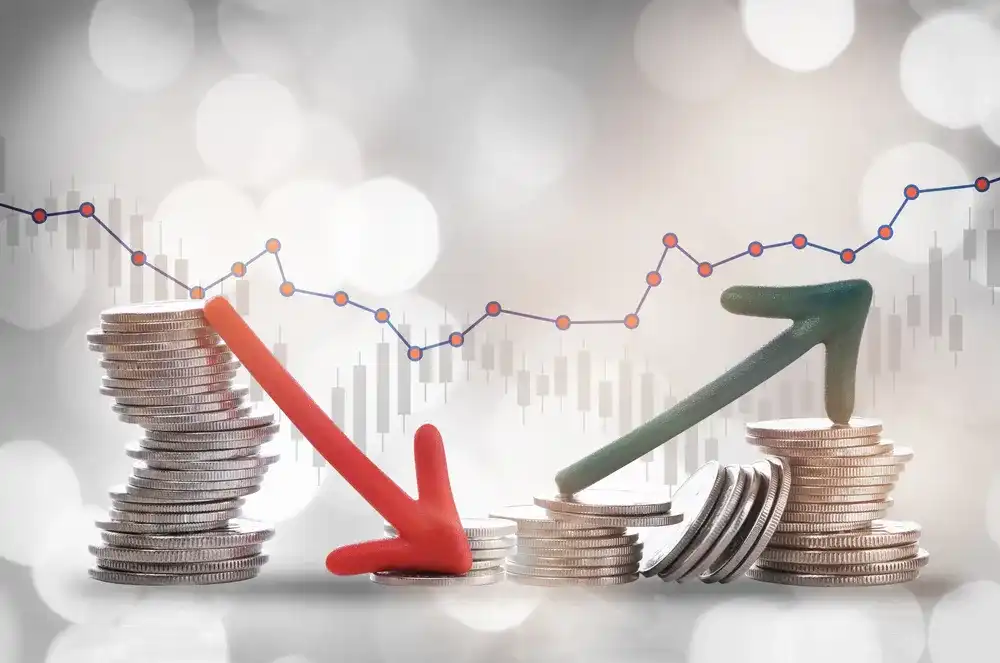From Boom to Bust: Lessons Learned from Market Cycles
Understanding market cycles is crucial for investors seeking stability and growth. This article takes you on a journey through the ever-evolving nature of market cycles, examining historical booms and busts to extract valuable insights.
We'll explore the recurring patterns, triggers, and key takeaways that can help investors navigate the often turbulent waters of the financial world. So, let's dive in and discover how knowledge of market cycles can be your compass in these uncertain times.

Understanding Market Cycles
Market cycles, a fundamental concept in the world of investing, are the recurring patterns of economic and financial fluctuations. These cycles encompass a spectrum of phases, from the exuberance of bull markets to the pessimism of bear markets and the various stages of expansions, recessions, and recoveries.
While each market cycle has its unique characteristics, there are overarching principles that can help investors navigate the complexities of economic cycles and investment patterns.
Economic Cycles: Unveiling the Four Phases
Let’s take a look at the intricacies of economic cycles. Consider the characteristics of the four primary phases.
1. Expansion
In the expansion phase, interest rates tend to be low, promoting borrowing by consumers and businesses. Growing demand for goods prompts businesses to boost production, driving corporate profits and stock prices upward. This phase marks the "boom" cycle of the economy, with rising Gross Domestic Product (GDP).
2. Peak
At the peak, the economy hits its maximum growth rate. Demand often outpaces supply, leading to rising production costs and inflation. The Federal Reserve may raise interest rates to control inflation, causing a slowdown in economic activity and corporate profits.
3. Contraction
The contraction phase witnesses declining consumer spending, falling corporate profits, and a bear market in stocks. Businesses may cut back on hiring or lay off workers. Government interventions like interest rate cuts and stimulus measures may be employed to revive the economy during severe contractions.
4. Recovery
The recovery phase follows the trough of the contraction. Policies initiated during the downturn begin to yield results, encouraging businesses to expand production, driving stock values higher. Employment, income, and GDP gradually rebound.
Market cycles are closely tied to these economic phases, and investors must adapt their strategies accordingly. Recognizing the cyclical nature of market and economic trends empowers investors to make informed decisions. Keep in mind that while market cycles offer valuable insights, they are not always predictable, and external factors can influence their trajectory.
In summary, grasping the dynamics of market and economic cycles is essential for investors seeking to successfully manage their portfolios. By studying historical patterns and understanding the distinct phases of these cycles, investors can enhance their ability to navigate the ever-changing landscape of financial markets.

Analyzing Historical Booms
Economic booms, characterized by periods of extraordinary market expansion and robust growth trends, have left their mark on history as compelling examples of financial prosperity. By examining a few noteworthy instances, we can uncover valuable insights into the factors fueling rapid economic growth during these boom periods.
One prominent example of an economic boom is the Roaring Twenties in the United States. This era, following World War I, saw an unprecedented surge in economic activity. Factors contributing to this boom included increased consumer spending, driven by innovations like the automobile, and a speculative frenzy in the stock market. The Roaring Twenties exemplified the exuberance of economic booms, marked by soaring stock prices and a seemingly insatiable appetite for investment.
Another remarkable case is the Japanese economic boom of the 1980s, often referred to as the "Japanese Miracle." During this time, Japan experienced remarkable market expansion driven by technological advancements, a booming real estate market, and a strong export-driven economy. The country became a global economic powerhouse, with its stock market reaching unprecedented heights.
These historical booms share common elements that contribute to their rapid growth. Factors such as technological innovation, increased consumer spending, and a positive investment climate are recurring themes. Additionally, access to capital through low interest rates and improved infrastructure can further fuel economic expansion during these periods.
By analyzing these economic booms, investors can gain a deeper understanding of the drivers behind rapid market expansion. Recognizing these factors can help investors identify potential opportunities and risks during periods of economic growth, enabling them to make more informed investment decisions.
Identifying Warning Signs of a Bust
As we assess the current state of the U.S. economy, it's worth noting that recent reports from Reuters indicate a faster-than-expected growth rate in the fourth quarter, with the economy expanding by 3.3% annually and an overall annual growth rate of 2.5%.
This positive performance has defied predictions of a looming recession, even after the Federal Reserve's aggressive interest rate hikes. Strong consumer spending, increased exports, government spending, and business investments have all contributed to this robust growth.
However, investors must remain vigilant, as economic booms can eventually give way to economic busts. A bust is characterized by a rapid decrease in economic growth, often accompanied by a stock market decline. During such periods, inflation tends to decrease, potentially leading to deflation, while unemployment rates rise, incomes fall, and aggregate demand dwindles.
Recognizing warning signs of an impending economic downturn is vital for safeguarding investments. Here are common indicators to watch for:
- Stock Market Volatility: Sustained declines and increased market volatility can signal trouble.
- Slowing Economic Growth: A significant drop in GDP growth rates is a clear warning sign.
- Rising Unemployment: A sharp increase in joblessness may indicate an economic downturn.
- Reduced Consumer Spending: When consumers tighten their belts, it can signify economic troubles.
- Falling Business Investment: Decreased business spending can lead to reduced economic activity.
Being attuned to these warning signs can help investors adjust their strategies to mitigate potential losses during a market decline or economic downturn. While the current economic outlook appears positive, it's wise to remain prepared for any future challenges that may arise in the ever-changing landscape of financial markets.

Lessons from Past Busts
Market crashes, often synonymous with financial crises, have left indelible marks on economic history, underscoring the importance of being prepared for post-bust recovery.
One of the most notorious market crashes in history was the Great Depression of 1929. Following the stock market crash of October 1929, investors saw the value of their portfolios plummet, leading to widespread financial hardship. The broader economy faced severe challenges, with unemployment soaring and businesses shuttering their doors. The lessons from this devastating event emphasize the need for proactive government intervention to stabilize the financial system and stimulate economic recovery.
Another significant market crash occurred during the global financial crisis of 2008. The housing market bubble burst, triggering a domino effect that impacted financial institutions worldwide. Investors witnessed the collapse of major banks and a sharp decline in stock markets. Central banks stepped in with aggressive measures, including interest rate cuts and stimulus packages, to jumpstart post-bust recovery.
These historical examples show the interconnectedness of market crashes and their far-reaching consequences. While the immediate aftermath can be challenging for investors, understanding the broader economic implications is crucial. Post-bust recovery often hinges on effective policy responses and investor resilience, emphasizing the importance of diversifying portfolios and maintaining a long-term perspective.
Risk Mitigation Strategies
Mitigating risks during market downturns is a paramount concern for investors. Here are some practical tips to help safeguard your investments and navigate challenging times:
- Diversify Your Portfolio: Spread your investments across various asset classes, such as stocks, bonds, real estate, and commodities. Diversification can help reduce the impact of market volatility on your overall portfolio.
- Stay Informed and Educated: Keep a close eye on economic indicators and market trends. Staying informed allows you to make informed decisions and adjust your investment strategy as needed.
- Maintain a Long-Term Perspective: Resist the urge to make impulsive decisions based on short-term market fluctuations. A long-term perspective can help you weather market downturns and capture potential gains when markets recover.
- Set Realistic Goals and Risk Tolerance: Define your investment objectives and assess your risk tolerance. Understanding your risk tolerance will guide you in making appropriate investment choices aligned with your financial goals.
- Implement Risk Management Strategies: Consider using stop-loss orders or trailing stop orders to limit potential losses on individual investments. These tools automatically sell a security if its price falls to a predetermined level.
- Regularly Rebalance Your Portfolio: Periodically review and rebalance your portfolio to ensure it aligns with your target asset allocation. This practice can help you maintain a diversified and risk-appropriate portfolio.
Diversification and effective risk management are fundamental to successful investment strategies. By following these strategies and staying disciplined in your approach, you can better navigate market downturns and work toward your long-term financial objectives.
The Role of Behavioral Economics
Market psychology often defies conventional fundamentals or events and plays an integral role in influencing market cycles. It's important to recognize that investor sentiment can sway market movements, sometimes independently of underlying economic realities. For instance, if investors suddenly lose confidence in the economy's health, they may withdraw from the stock market, causing overall market indexes to decline. This decline affects individual stock prices, irrespective of the financial performance of the underlying companies.
Greed, fear, expectations, and euphoria are emotional states that significantly contribute to market psychology. These emotions can trigger alternating "risk-on" and "risk-off" sentiments, leading to boom and bust cycles in financial markets.
Similarly, behavioral economics explores human psychology and its impact on investment decisions. It reveals that investors often make irrational choices influenced by cognitive biases and emotional responses. These behavioral tendencies can lead to herd behavior, where investors follow the crowd rather than make independent judgments.
Understanding the role of behavioral economics in investor decision-making is crucial for anyone navigating the financial markets. It highlights the importance of disciplined and rational decision-making and the need to recognize and counteract emotional biases that may cloud judgment.

Adapting Investment Strategies
The ability to adapt your investment strategy is a must. Here are some tips on how to adjust your investment strategies based on different phases of the market cycle:
- Focus on Growth Stocks: Growth stocks tend to shine during the expansion phase. These companies are characterized by high earnings growth and typically outperform other stocks in a growing economy. Consider allocating a portion of your portfolio to growth-oriented sectors such as technology and consumer discretionary to capitalize on the positive momentum.
- Defensive Sector Allocation: In anticipation of economic downturns, allocating a significant portion of your portfolio to defensive sectors like utilities and healthcare is wise. Defensive stocks are less sensitive to economic fluctuations and can stabilize market contractions.
- Stay Flexible and Adaptable: The key to successful adaptive investment is flexibility. It allows for effective risk management, profit-taking opportunities, and strategic maneuverability. Be open to adjusting your portfolio mix as market dynamics evolve.
By incorporating flexible strategies into your investment approach, you can better navigate the dynamic nature of financial markets. This adaptability lets you seize opportunities during market upswings and protect your investments during downturns.
Further, options trading is one way to implement adaptable strategies. It allows traders to hedge against potential losses and profit from market volatility. By leveraging options, investors can tailor their positions to align with changing market conditions.
Long-Term Investment Mindset
A long-term investment mindset is not just a strategy; it's a philosophy that champions patience, resilience, and the ability to weather the stormy seas of market cycles. In the world of finance, there are shining examples of successful investors who have demonstrated the power of steadfast commitment to a long-term investment approach.
One of the most renowned figures in this regard is Warren Buffett. His track record of consistently outperforming the market over decades stands as a testament to the value of maintaining a long-term perspective. Buffett's ability to see beyond short-term fluctuations and focus on the intrinsic value of investments has made him one of the most celebrated investors of our time.
Peter Lynch, another investment luminary, is celebrated for his remarkable tenure at the helm of the Fidelity Magellan Fund. His "buy what you know" philosophy emphasized understanding the businesses behind the stocks, and his results demonstrated the rewards of maintaining a long-term investor mindset.
John Templeton, known for his contrarian approach and global perspective, is a prime example of market resilience. He thrived during challenging times by recognizing opportunities where others saw only adversity.
In essence, these legendary investors underscore the enduring importance of adopting a long-term investment mindset. Market resilience isn't about dodging every wave but about navigating the entire ocean of market cycles with unwavering confidence in your long-term vision.
Patience, Resilience, and Long-Term Perspective Are the Key to Thriving Amidst Varying Market Cycles
One timeless truth remains - understanding historical market cycles equips investors with invaluable insights for the future. From the wisdom of legendary investors like Warren Buffett, Peter Lynch, and John Templeton, we've learned that patience, resilience, and a long-term perspective are the cornerstones of success in the volatile world of investments.
As we navigate the unpredictable seas of market cycles, let's remember that every downturn carries the potential for an eventual upswing. By learning from the past, we can chart a steadier course ahead.
We encourage you to apply these lessons to your own investment strategies, building upon the foundations of knowledge and wisdom that history has to offer.
The content on this page provides general consumer information or tips. It is not financial advice or guidance. Each person’s circumstances are unique. The Cash Store may update this information periodically. This information may also include links or references to third-party resources or content. We do not endorse the third-party or guarantee the accuracy of this third-party information. There may be other resources that also serve your needs.
More Articles
What to Know About Crypto-Backed Loans
Curious about using your crypto as collateral? Discover how crypto-backed loans work, their benefits, risks, and what to consider before borrowing.
Read More >How Does Installment Loan Approval Work?
Curious about how installment loan approval works? Learn about the key factors lenders consider, the application process, and tips to improve your chances of approval.
Read More >Is it Better to Get an Installment Loan or Line of Credit?
Installment loan or line of credit—which is right for you? Learn the key differences, pros and cons, and how to choose the best option for your financial needs.
Read More >Loan Amount is subject to loan approval. Loan terms and availability may vary by location. Approval rate based on complete applications received across all Cash Store locations. Customers can typically expect to receive loan proceeds in less than 20 minutes; however, processing times may vary. Loans / Advances are provided based on approved credit. Each applicant for credit is evaluated for creditworthiness.
Please see the Licenses and Rates page for additional product details.
Cash Store offers consumer credit products that are generally short-term in nature and not intended for long-term borrowing needs.
In Texas, Cash Store is a Credit Services Organization. Loans are provided by a non-affiliated third-party lender. Please see the Licenses and Rates page for links to Consumer Disclosures and choose the one for the product and amount that most closely relates to your loan request.
Customer Portal residency restrictions apply. Availability of funds may vary by financial institution.

